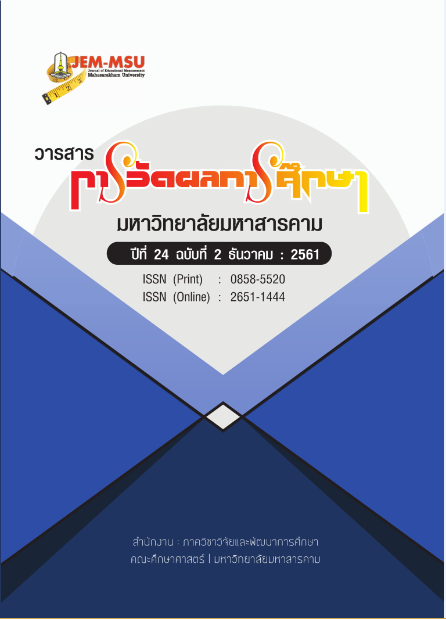Analysis of the Formative Assessment Skill of Teachers in Sa Kaeo Province
Main Article Content
Abstract
The purposes of this research were to develop an evaluation form of formative assessment skills and to compare the formative assessment process skill of teachers in Sa Kaeo Province, classified by sex and organization of affiliation. The sample comprised 130 teachers under the Office of Sa Kaeo Primary Education Service Area, and the Office of Sa Kaeo Secondary Education Service Area, in the second semester of the academic year 2016, obtained through multi-stage sampling. The research instrument was a 6-level rating scale assessment form. Two-way MANOVA was employed in the analysis of data.
The results indicated that:
- The evaluation form of the formative assessment skill had 5 components with 115 items. They were: 1) goal-oriented learning of students, with 17 items; 2) learning feedback, with 18 items; 3) learning evaluation method, with 36 items; 4) pedagogical content knowledge, with 27 items; and 5) learning experiences, with 17 items. They exhibited the item-level CVI of 1.00, and scale-level CVI of 1.00. The discrimination ranged between .215 and .814, and the internal consistency was .938.
- The comparison of the formative assessment skill, classified by gender and organization of affiliation, revealed that there was a statistically significant difference at the .01 level (F = 5.78 and 11.59 respectively). Female teachers had the process skill at a very good level and it was better than male teachers whose process skill was at a good level. And the teachers under the Office of Sa Kaeo Secondary Education Service Area had better skill than the teachers under the Office of Sa Kaeo Primary Education Service Area.
Article Details
The content and information contained in the published article in the Journal of Educational Measurement Mahasarakham University represent the opinions and responsibilities of the authors directly. The editorial board of the journal is not necessarily in agreement with or responsible for any of the content.
The articles, data, content, images, etc. that have been published in the Journal of Educational Measurement Mahasarakham University are copyrighted by the journal. If any individual or organization wishes to reproduce or perform any actions involving the entirety or any part of the content, they must obtain written permission from the Journal of Educational Measurement Mahasarakham University.
References
http://data.bopp-obec.info/emis [สืบค้นเมื่อ วันที่ 26 พฤษภาคม 2558].
กัลยานี กาซอ, เรวดี กระโหมวงศ์ และสุเทพ สันติวรานนท์. (2556). การประเมินผลการปฏิบัติงานของครู
ระดับประถมศึกษาตามมาตรฐานวิชาชีพทางการศึกษา พระราชบัญญัติสภาครูและบุคลากรทางการ
ศึกษา สำนักงานเขตพื้นที่การศึกษาประถมศึกษาปัตตานี เขต 3. วารสาร AL-NUR บัณฑิตวิทยาลัย.
มหาวิทยาลัยอิสลามยะลา. 7(13).
การศึกษา. (2558). แนวทางการแก้ไขปัญหาพฤติกรรมและค่านิยมทางสังคมที่ไม่เหมาะสมของนักเรียน นิสิต.
[ออนไลน์]. แหล่งที่มา: http://www.commonsenseforpubliceducation.org/13/51/
[สืบค้นเมื่อ วันที่ 26 พฤษภาคม 2559].
ขจิตรารัตน์ แสนรัมย์ และสงวน ทรงวิวัฒน์. (2555). สภาพการบริหารงานด้านการวัดและประเมินผลการ
เรียนรู้ของโรงเรียนในสังกัดสำนักงานเขตพื้นที่การศึกษาประถมศึกษาบุรีรัมย์ เขต 3. วิทยานิพนธ์
หลักสูตรครุศาสตรมหาบัณฑิต สาขาวิชาการบริหารการศึกษา มหาวิทยาลัยราชภัฏบุรีรัมย์.
คอดารียะห์ เสกเมธี, ชิดชนก เชิงเชาว์, และณัฐวิทย์ พจนตันติ. (2551). การศึกษาเทคนิคการจัดการเรียน
การสอนของครู: กรณีศึกษา ครูที่ได้รับรางวัลพระราชทานในโรงเรียนเอกชนสอนศาสนาอิสลาม
จังหวัดปัดตานี. วารสารศึกษาศาสตร์ มหาวิทยาลัยนเรศวร.
จริยาพร สังขรัตน์, พงศ์ประพันธ์ พงษ์โสภณ, และสมบุญ เตชะภิญญาวัฒน์. (2555). เส้นทางการเป็นครู
วิทยาศาสตร์ดีเด่นระดับประถมศึกษา: กรณีศึกษาสำนักงานกองทุนสนับสนุนงานวิจัย, กรุงเทพฯ:
สำนักพิมพ์มหาวิทยาลัยเกษตรศาสตร์ สำนักหอสมุด.
เชิดศักดิ์ ไอรมณีรัตน์. (2552). การให้ข้อมูลย้อนกลับ (Providing feedback). แหล่งข้อมูลด้านแพทยศาสตร
ศึกษา มหาวิทยาลัยสงขลานครินทร์. [ออนไลน์]. แหล่งที่มา:
http://teachingresources.psu.ac.th/other_articles.php.pdf [ สืบค้นเมื่อ วันที่ 21 มิถุนายน
2559]
ฐิติพงษ์ ตรีศร. (2552). สมรรถนะการปฏิบัติงานของครูในสถานศึกษา สังกัดสำนักงานเขตพื้นที่การศึกษา
เพชรบูรณ์ เขต 3. วิทยานิพนธ์ครุศาสตรมหาบัณฑิต สาขาวิชาการบริหารการศึกษา บัณฑิต
วิทยาลัย มหาวิทยาลัยราชภัฏเพชรบูรณ์.
มาเรียม นิลพันธ์, ไชยยศ ไพวิทยศิริธรรม, ศิริวรรณ วณิชวัฒนวรชัย และอุบลวรรณ ส่งเสริม. (2558).
การประเมินผลการใช้หลักสูตรแกนกลางการศึกษาขั้นพื้นฐาน พุทธศักราช 2551 ในโรงเรียน
ต้นแบบการใช้หลักสูตร. วารสารศิลปากรศึกษาศาสตร์วิจัย มหาวิทยาลัยศิลปากร. 7(1): 26-41.
ยุทธชัย ศรบุญลา, พชรวิทย์ จันทร์ศิริสิร และจตุพร เหลืองอุบล. (2558). การเปรียบเทียบสมรรถนะประจำ
สายงานของครู ระดับมัธยมศึกษาในจังหวัดมหาสารคาม. วารสารศึกษาศาสตร์ มหาวิทยาลัย
มหาสารคาม. 9(1): 48-56.
วิจารณ์ พานิช. (2555). วิถีสร้างการเรียนรู้เพื่อศิษย์ในศตวรรษที่ 21. พิมพ์ครั้งที่ 1. กรุงเทพฯ: มูลนิธิ
สดศรี-สฤษดิ์วงศ์.
สนธิ สถาพร และดวงใจ ชนะสิทธิ์. (2559). การบริหารงานวิชาการที่ส่งผลต่อประสิทธิผลของการจัดการเรียน
การสอนที่เน้นผู้เรียนเป็นสำคัญของสถานศึกษา สังกัดสำนักงานเขตพื้นที่การศึกษามัธยมศึกษา
เขต 9. วารสารศิลปากรศึกษาศาสตร์วิจัย มหาวิทยาลัยศิลปากร. 8(1): 362-377.
สมจิต จันทร์ฉาย. (2557). การออกแบบและพัฒนาการเรียนการสอน. คณะครุศาสตร์. มหาวิทยาลัยนครปฐม.
สำนักทดสอบทางการศึกษา. (2560) รายงานผลการประเมินคุณภาพผู้เรียนระดับชาติ ปีการศึกษา 2558 :
บทสรุปและข้อเสนอแนะเชิงนโยบาย. พิมพ์ครั้งที่ 1. กรุงเทพฯ: โรงพิมพ์ชุมนุมสหกรณ์การเกษตร
แห่งประเทศไทย จำกัด.
สำนักนโยบายและแผนการศึกษาขั้นพื้นฐาน. (2557). นโยบายสำนักงานคณะกรรมการการศึกษาขั้นพื้นฐาน
ปีงบประมาณ พ.ศ. 2557. กลุ่มวิจัยและพัฒนานโยบาย กระทรวงศึกษาธิการ.
สำนักวิชาการและมาตรฐานการศึกษา. (2553). แนวปฏิบัติการวัดและประเมินผลการเรียนรู้ตามหลักสูตร
แกนกลางการศึกษาขั้นพื้นฐาน พุทธศักราช 2551. พิมพ์ครั้งที่ 2. กรุงเทพฯ: โรงพิมพ์ชุมนุม
สหกรณ์การเกษตรแห่งประเทศไทย จำกัด.
Black, P., & Wiliam, D. (1998). Assessment and classroom learning. Assessment in Education
Principles, Policy & Practice. 5(1): 7–75.
Bell, B., & Cowie, B. (1999). Formative assessment and science education. London: Kluwer
Academic Publishers.
Cerbin, W., & Kopp, B. (2006). Lesson Study as a Model for Building Pedagogical Knowledge
and Improving Teaching. International journal of teaching and learning in higher
education. 18(3): 250-257.
Hatti, J. & Temperly, N. (2007). The power of feedback. Review of Educational Research.
77(1): 81-112.
Harlen, W. (1998). Classroom assessment a dimension of purpose and procedures, Paper
presented at the Annual Conference of the New Zealand Association For
Research in Education. Dunedin: New Zealand.
Shambaugh, R. N. & Magliaro, S. L. (1997). Mastering the possibilities. Massachusetts: Allyn
and Bacon.
Tsai, F. H., Tsai, C. C., & Lin, K. Y. (2015). The evaluation of different gaming modes and
feedback types on game-based formative assessment in an online learning
environment. Computers & Education. 81: 259-269.


